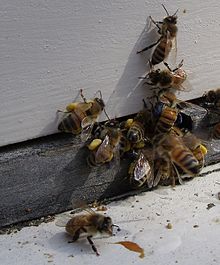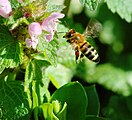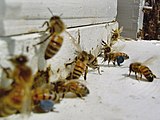The term pollen source is often used in the context of beekeeping and refers to flowering plants as a source of pollen for bees or other insects. Bees collect pollen as a protein source to raise their brood. For the plant, the pollinizer , this can be an important mechanism for sexual reproduction , as the pollinator distributes its pollen. Few flowering plants self-pollinate ; some can provide their own pollen (self fertile), but require a pollinator to move the pollen; others are dependent on cross pollination from a genetically different source of viable pollen, through the activity of pollinators. One of the possible pollinators to assist in cross-pollination are honeybees. The article below is mainly about the pollen source from a beekeeping perspective.
Bee collecting pollen from rata Pollen-laden bees at hive entrance Bee on plum tree with pollen The pollen source in a given area depends on the type of vegetation present and the length of their bloom period. What type of vegetation will grow in an area depends on soil texture, soil pH , soil drainage, daily maximum and minimum temperatures, precipitation, extreme minimum winter temperature, and growing degree days . The plants listed below are plants that would grow in USDA Hardiness zone 5. A good predictor for when a plant will bloom and produce pollen is a calculation of the growing degree days.
The color of pollen below indicates the color as it appears when the pollen arrives at the beehive. After arriving to the colony with a fresh load of pollen, the honey bee unloads its pollen from the pollen basket located on its hind legs. The worker bees in the colony mix dry pollen with nectar and/or honey with their enzymes, and naturally occurring yeast from the air. Workers then compact the pollen. storing each variety in an individual wax hexagonal cell (honeycomb ), typically located within their bee brood nest. This creates a fermented pollen mix call beekeepers call 'bee bread'. Dry pollen, is a food source for bees, which may contain 16–30% protein, 1–10% fat, 1–7% starch, many vitamins, some micro nutrients, and possibly a little sugar. The protein source needed for rearing one worker bee from larval to adult stage requires approximately 120 to 145 mg of pollen. An average bee colony will collect about 20 to 57 kg (44 to 125 pounds) of pollen a year.[1] [2]
Trees and shrubs – Spring edit Common name Latin name Blooming months Pollen color Availability Source for honeybees Maple Acer spp.Feb – Apr light yellow feral fair Manitoba Maple (Box elder)Acer negundo Feb – Apr light olive feral good Norway maple Acer platanoides Apr – May yellow green, olive feral fair Red Maple Acer rubrum Mar – Apr grey brown feral Grey Alder Alnus incana Feb – Apr brownish yellow feral American Chestnut Castanea dentata May – Jun mostly ornamental Sweet Chestnut Castanea sativa May feral good Common Hackberry Celtis occidentalis Apr – May feral Flowering Quince Chaenomeles japonica , Chaenomeles lagenaria , Chaenomeles speciosa 'Nivalis' , Chaenomeles x superba Apr – May feral good American Hazel Corylus americana Mar – Apr light green feral and ornamental fair/good Hawthorn Crataegus spp.Apr – May yellow brown feral fair White Ash Fraxinus americana Apr – May Honey Locust Gleditsia triancanthos May – Jun feral American holly Ilex opaca Apr – Jun feral Walnut Juglans spp.Apr – May cultivated fair Tulip-tree Lirodendron tulipifera May – Jun cream feral and ornamental good Crab Apple Malus spp.Mar – Jun light olive ornamental Apple Malus domestica, Malus sylvestris Apr – May yellow white cultivated and ornamental very good American Sycamore Platanus occidentalis Apr – May light olive feral Plum Prunus spp.Apr – May light grey, grey ornamental and cultivated Almond Prunus amygdalus Feb light brown to brown pollen – not considered a good pollen source but bees are the primary pollinator cultivated mostly in California fair Wild Cherry Prunus avium Apr – May yellow brown, light brown feral very good Cherry Plum Prunus cerasifera light brown to brown feral fair Sour Cherry Prunus cerasus Apr – May dark yellow ornamental and cultivated very good Peach Prunus persica Apr – May reddish yellow ornamental and cultivated good Black Cherry Prunus serotina Apr – May feral minor Blackthorn Prunus spinosa Mar – May firebrick feral good Pear Pyrus communis Apr – May red yellow ornamental and cultivated good Oak Quercus spp.May feral Oak Quercus robur , Quercus pedunculata May light olive feral minor Black Locust Robinia pseudoacacia May – Jun feral Blackberry Rubus spp.May – Jun light grey feral and cultivated Raspberry Rubus idaeus May – Jun white grey feral and cultivated good Willow Salix spp.Feb – Apr lemon feral good White Willow Salix alba feral good Goat Willow Salix caprea Mar – Apr feral very good Violet Willow Salix daphnoides Mar – Apr feral very good Pussy Willow Salix discolor Mar – Apr feral and ornamental Basket Willow Salix purpurea Mar – Apr feral very good Silky leaf osier, Smith's Willow Salix x smithiana Apr – May very good American mountain ash Sorbus americana May-Jun feral American Elm Ulmus americana Feb – Apr light grey feral Winged Elm Ulmus alata Feb – Mar pale yellow feral good European field elm Ulmus minor feral good
Flowers and annual crop plants – Spring edit Common name Latin name Blooming months Pollen color Availability Source for honeybees Ajuga (Bronze Bugle, Common Bugle)Ajuga reptans mid spring Chives Allium schoenoprasum May – Sep cultivated? Asparagus Asparagus officinalis May – Jun bright orange cultivated Mustard Brassica arvenisi Apr – May lemon cultivated and feral Canola (Oilseed Rape)Brassica napus May – Jun lemon extensively cultivated very good Yellow Crocus Crocus vernus Crocus aureus )April orange yellow feral and ornamental fair Leopard's Bane Doronicum cordatum Apr – May Winter aconite Eranthis hyemalis Mar – Apr yellow feral and ornamental good Snowdrop Galanthus nivalis Mar – Apr orange, red fair Henbit Lamium amplexicaule April orange red, red, purplish red Apr – Jul poor Common Mallow Malva sp. Apr – Sep mauve feral good White Sweet Clover Melilotus alba May – Aug yellow to dark yellow feral and cultivated good Yellow Sweet Clover Melilotus officinalis May – Aug yellow to dark yellow feral and cultivated Sainfoin Onobrychis viciifolia May – Jul yellow brown very good Siberian squill Scilla siberica Mar – Apr steel blue feral and ornamental good White mustard Sinapis alba June lemon feral and cultivated good Chick weed Stellaria media Apr – Jul yellowish feral minor Dandelion Taraxacum officinale Apr – May red yellow, orange feral very good Gorse Ulex europaeus Mar – Dec light firebrick feral good
Trees and shrubs – Summer edit Common name Latin name Blooming months Pollen color Availability Source for honeybees Red Horse chestnut Aesculus carnea raisin [3] feral Horse chestnut Aesculus hippocastanum May – Jun after 80-110 growing degree days. anatolia [3] feral good Southern Catalpa Catalpa bignonioides Jun – Jul ornamental fair Northern Catalpa Catalpa speciosa Jun – Jul ornamental Bluebeard Caryopteris x clandonensis 'Heavenly Blue' Aug – Sep very good Virginia creeper Parthenocissus quinquefolia Jul – Aug good Boston Ivy 'Veitchii' Parthenocissus tricuspidata 'Veitchii' Jun – Jul good Sumac Rhus glabra Jun – Jul Elder Sambucus canadensis Jun – Jul canary yellow [3] Basswood or American LindenTilia americana Jun – Jul yellow to light orange feral and ornamental Little Leaf Linden Tilia cordata citrine [3] feral Blueberry Vaccínium myrtíllus Jun red yellow, orange cultivated poor
Flowers and annual crop plants – Summer edit Common name Latin name Blooming months Pollen color Availability Source for honeybees Allium Allium spp.feral and cultivated Onion Allium cepa light olive cultivated Chives Allium schoenoprasum May – Sep feral and cultivated Garlic chives Allium tuberosa Aug – Sep feral and cultivated Leadwort syn. Indigobush Amorpha fruticosa Jun – Jul ornamental? Aster Aster spp.Sep-Frost reddish yellow feral and ornamental Land-in-blue , Bushy AsterAster x dumosus Aug – Sep bronze yellow [3] feral Borage Borago officinalis Jun – Frost blueish grey ornamental Marigold Calendula officinalis Jun – Sep orange Heather sp.Calluna vulgaris Jul – Aug yellow white, white good Hemp Cannabis sativa Aug yellow green good source Blue Thistle Carduus spp.Star thistle Centaurea spp.Jul – Sep Persian centaurea Centaurea dealbata hemp [3] Knapweed Centaurea macrocephala Jul – Aug good Knapweed Centaurea nigra very light olive Chicory [4] Cichorium intybus L. white Cotoneaster Cotoneaster spp.good Cucumber Cucumis spp.pale yellow cultivated Melons Cucumis melo Jun-Frost pale yellow cultivated Pumpkin Cucurbita pepo Jun-Frost bright yellow cultivated Fireweed (Rosebay Willowherb)Epilobium angustifolium Jul – Aug blue feral Joe-Pye weed , BluestemEutrochium spp.; Eupatorium purpureum Aug – Sep bistre green Buckwheat Fagopyrum esculentum Jul – Aug light yellow to light green cultivated good source Blue vine Gonolobus laevis syn. Cynanchum laeve Sunflower Helianthus annuus Jun – Sep golden feral and cultivated Jewelweed Impatients capensis yellowish white Alyssum Lobularia maritima Jun – Sep Lupin Lupinus sp. Jun – Jul white, yellow or blue minor Mallow Malva sylvestris Jun – Sep Alfalfa Medicago sativa July – Aug khaki [3] feral and cultivated Clover Melilotus spp. and Trifolium spp.May – Aug feral and cultivated White Sweet Clover Melilotus alba auburn [3] feral and cultivated Yellow Sweet Clover Melilotus officinalis auburn [3] feral and cultivated Basil Ocimum basilicum white ornamental Poppy Papaver orientale May – Jul blueish grey ornamental only good source [5] Opium poppy Papaver somniferum May – Jun grey feral and ornamental very good source Phacelia Phacelia tanacetifolia Jun – Sep navy blue feral and cultivated good source Smartweed Polygonum spp.Aug – Sep Common Chickweed Stellaria media Apr – Jul minor source Germander Teucrium chamaedrys Jul – Aug Alsike Clover Trifolium hybridum yellow brown good source Crimson Clover Trifolium incarnatum dark brown White Clover Trifolium repens Jun – Jul caledonian brown good source Cat-tail Typha latifolia Jun – Jul Common vetch [verification needed Vicia cracca Jul – Aug Spring Vetch [verification needed Vicia sativa Jul – Aug Sweet Corn Zea mays Jun – Jul yellowish white cultivated
Trees and shrubs – Fall edit Common name Latin name Blooming months Pollen color Availability Source for honeybees Chinese Elm , Lacebark ElmUlmus parvifolia Aug – Sep ornamental good
Flowers and annual crop plants – Fall edit Common name Latin name Blooming months Pollen color Availability Source for honeybees Aster Aster spp.Sep-Frost reddish yellow Borage Borago officinalis Jun – Frost Melons Cucumis melo Jun-Frost cultivated Sweet autumn clematis Clematis ternifolia late Sept white ornamental Pumpkin Cucurbita pepo Jun-Frost bright yellow cultivated Ivy Hedera spp.Sep – Oct dull yellow or black? feral and ornamental Goldenrod Solidago spp.Sep – Oct golden feral
[6] [7] [8] [9] [10]
See also edit References edit ^ THE R-VALUES OF HONEY: POLLEN COEFFICIENT Archived 2006-07-24 at the Wayback Machine accessed Feb 2005^ Reiter, R, THE COLORATION OF ANTHER AND CORBICULAR POLLEN , THE OHIO JOURNAL OF SCIENCE, VOL. XLVII JULY, 1947 No. 4, Camden, N. J. ^ a b c d e f g h i https://kb.osu.edu/dspace/bitstream/1811/3589/1/V47N04_137.pdf [bare URL PDF ^ Legan, Christiaan (2012-07-21), mmm... chicory , retrieved 2019-07-18 ^ Die Honig Macher ( in German )^ Bienenweide Arbeitsblatt 207, Bieneninstitut Kirchhain, 2001 ^ Tew, James Some Ohio Nectar and Pollen Producing Plants Ohio State University Extension Fact Sheet, 2000 ^ Stahlman, Dana Honey Plants Flowering Plants/Trees 2004 ^ Hodges, Dorothy; The pollen loads of the honeybee, Bee Research Association Limited, London, 1952 ^ Lamp, Thomas; Bienennährpflanzen 1 : Gehölze Nov 1999; accessed 05/2005 





